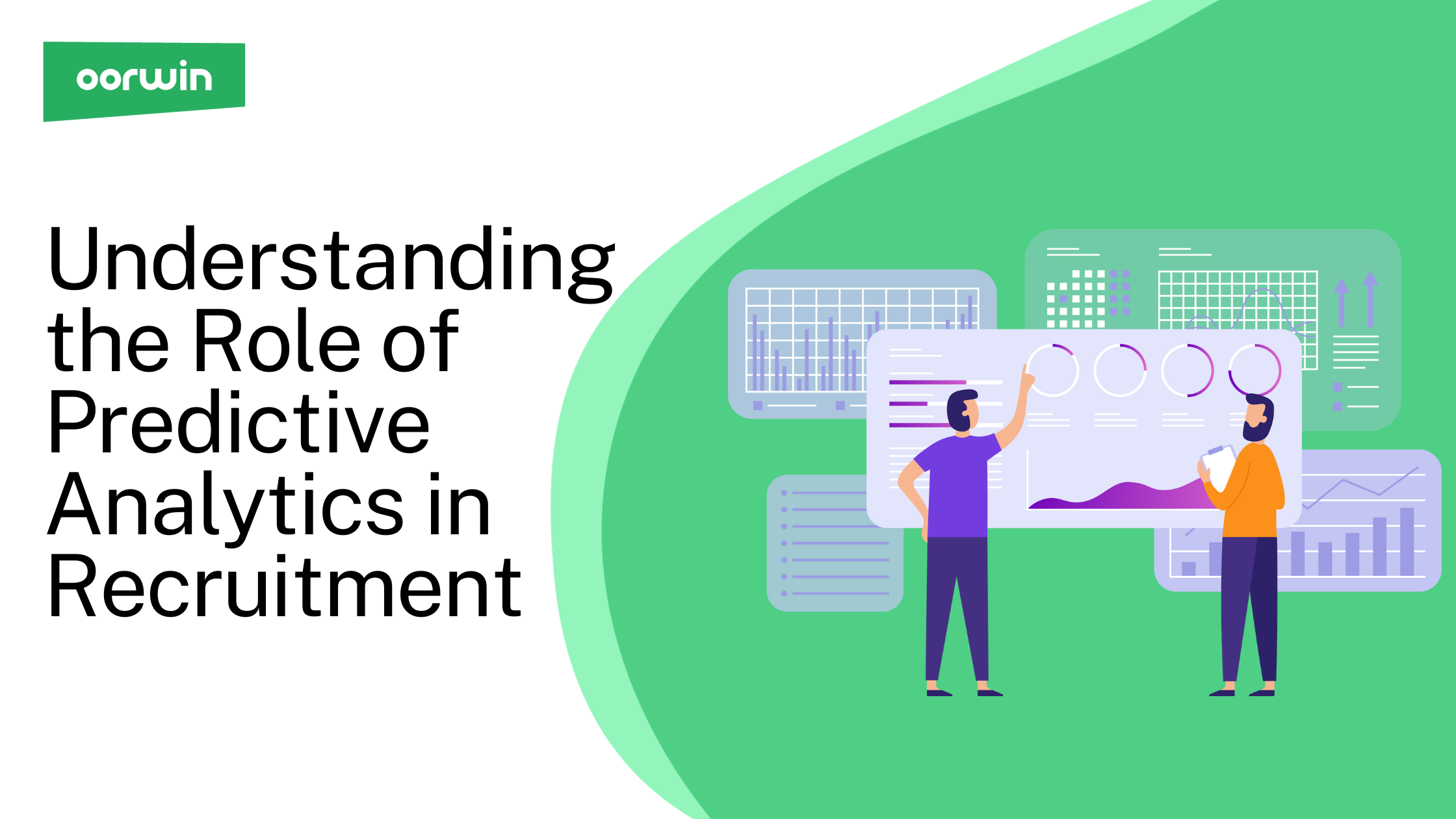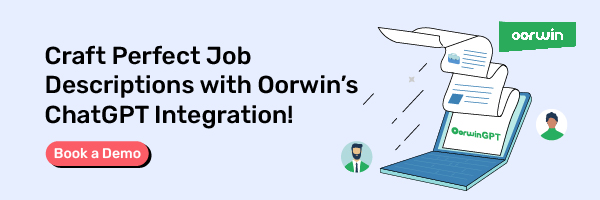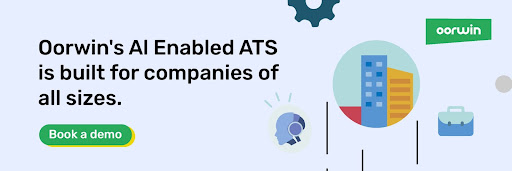Predictive Analytics in Recruitment: Future’s Blueprint
Oorwin
9min read / 29 Dec 2023

Related Articles
Exploring the Recruitment Landscape with Predictive Analytics
Predictive analytics is revolutionizing recruitment by enabling data-driven decision-making. This approach uses historical data and current trends to predict future hiring needs, ensuring more efficient and accurate talent acquisition. It’s not just about filling roles; it’s about finding candidates who will thrive long-term.
This technology also reduces biases in hiring, promoting a fair and diverse workplace. By focusing on data over intuition, companies can make objective decisions, leading to a more inclusive recruitment process. We’ll explore how predictive analytics streamlines hiring and improves job fit and retention, delving into real-world applications and future implications.
How is Predictive Analytics changing the Recruitment Scenario
Predictive analytics in recruitment is a sophisticated approach that harnesses data, statistical algorithms, and machine learning to forecast hiring outcomes. This method involves analyzing historical data to identify patterns and trends. Doing so anticipates future recruitment needs and challenges, enabling organizations to prepare more effectively. Predictive analytics helps identify the most suitable candidates, predict employee success, and reduce turnover rates. It shifts the recruitment paradigm from reactive to proactive, allowing companies to strategize and make informed, data-driven decisions. This technology transforms recruitment into a more efficient, precise, and cost-effective process.
Examples of Predictive Analytics in Action within Recruitment
To illustrate the practical applications and benefits of predictive analytics in the recruitment process, here are some real-world scenarios where this technology plays a pivotal role:
1. Candidate Success Prediction
For instance, a tech company might use predictive analytics to analyze past hiring data and identify characteristics of successful software engineers. This could include factors like specific coding skills, educational background, or even personality traits. By applying these insights to current applicants, the company can more accurately predict which candidates are likely to succeed in the role.
2. Turnover Reduction
A retail chain could employ predictive analytics to understand why employees leave within the first year. By examining data points such as work schedules, store locations, and employee feedback, they can identify patterns that lead to high turnover. This information can then be used to make changes in their recruitment and management strategies, such as adjusting work hours or enhancing training programs, to retain employees longer.
3. Talent Pool Analysis
A healthcare organization might use predictive analytics to forecast future staffing needs based on patient growth trends. By analyzing historical hiring data, patient volumes, and staff turnover rates, they can predict when and where they will need more nurses or doctors. This allows them to proactively build a talent pipeline, ensuring they have the right staff in place when needed.
4. Diversity and Inclusion
A multinational corporation could use predictive analytics to enhance diversity in its workforce. By analyzing recruitment data, they can identify biases in their hiring process and make data-driven changes to attract and retain a more diverse pool of candidates.
5. Performance Forecasting
An advertising agency might use predictive analytics to determine which candidates are likely to perform best in creative roles. By analyzing data from past campaigns, employee performance reviews, and creative outputs, they can identify traits and skills that correlate with high performance in these roles.
The Journey of Predictive Analytics in Recruitment
In recruitment, the use of predictive analytics is a process that starts by collecting basic data, such as applicant resumes, job performance metrics, and hiring outcomes. This data is then analyzed to identify patterns and trends. Next, these insights are used to create models that predict outcomes.
Throughout this process, the analytics are continuously refined and updated with new data, ensuring that the insights stay relevant and accurate. This cycle of collecting data, analyzing it, and applying the insights makes recruitment more efficient and effective. Lets dive deeper to understand more about this.
Collect Data
The initial step involves collecting extensive data from varied sources such as resumes, social media, job boards, and internal databases. This phase is critical as the quality and breadth of data collected directly impact the effectiveness of the predictive model. It’s about gathering as much relevant and diverse information as possible to create a robust foundation for analysis.
Pre-processing Data
Once data is collected, pre-processing begins. This phase involves cleaning and organizing the data to ensure its quality and usability. It includes removing inconsistencies, handling missing values, and normalizing data formats. This step is crucial for maintaining the integrity of the predictive analytics process, as accurate and well-structured data is essential for reliable outcomes.
Determine the Specific Analytical Approach
Determining the specific analytical approach involves selecting appropriate algorithms and models that best fit the recruitment objectives. This step requires understanding the nuances of different predictive models and choosing the one that aligns with the desired recruitment outcomes, such as candidate success prediction or identifying skills gaps. It’s a strategic decision that shapes the direction and effectiveness of the predictive analytics process.
Educating the Predictive Model
Educating the predictive model is about training it with historical data. This process allows the model to learn from past recruitment patterns and outcomes. The model’s accuracy improves as it processes more data, making its predictions more reliable. This step is iterative and evolves as more data becomes available, ensuring the model remains relevant and effective.
Executing Predictions
Executing predictions involves applying the trained model to new datasets to forecast future recruitment outcomes. This phase translates the model’s learned patterns into practical predictions, such as identifying potential successful candidates or forecasting hiring needs. This actionable intelligence supports strategic decision-making in recruitment, allowing for more efficient and targeted hiring processes.
Act on Insights
Acting on insights is the culmination of the predictive analytics process. It involves using the predictions to inform and guide recruitment strategies. This may include adjusting hiring criteria, refining job descriptions, or altering sourcing methods. Acting on these insights means making data-driven decisions that enhance recruitment efficiency, reduce time-to-hire, and improve the overall quality of hires.
Benefits of Using Predictive Analytics in Recruitment
Embracing predictive analytics in recruiting can significantly transform how organizations identify and secure top talent. This technology brings precision and efficiency to the hiring process, allowing recruiters to make well-informed decisions. Here are some of the key benefits of integrating predictive analytics into your recruitment strategy:
- Better Hiring Decisions: Predictive analytics helps recruiters pick candidates who are just right for the job. This means fewer hiring mistakes and more successful placements.
- Saves Time and Money: This approach makes the hiring process quicker and less costly. It finds the best candidates faster, meaning recruiters don’t waste time on less suitable options.
- Less Bias: It’s common for unconscious biases to sneak into recruitment decisions. Predictive analytics makes things fairer by focusing on what really matters – skills and potential, not personal biases.
- Keeps Employees Longer: When you hire the right people, they’re likely to stay with the company longer. Predictive analytics helps find these perfect matches, leading to happier employees who stick around.
Challenges and Ethical Points to Consider
While predictive analytics in recruiting has lots of pluses, it’s important to remember the challenges and ethical issues. Keeping candidates’ personal information safe, making sure the data is used responsibly, and avoiding biases in the system are key. Being open about how data is used and regularly checking if the system is fair and working well are good ways to handle these concerns.
How to Initiate the Process of Predictive Analytics in Recruitment
Initiating predictive analytics in recruitment requires strategic planning, focusing on technological readiness and clear objectives.
Selecting Your Technology Tools
The first step is selecting appropriate technology tools. These should handle vast datasets and complex algorithms while adaptable to specific recruitment needs. The ideal tools offer scalability, user-friendliness, and integration capabilities with existing systems. They should support various predictive models and provide accurate, timely insights to drive recruitment strategies.
Choosing Your KPIs
Key Performance Indicators (KPIs) are essential for tracking the effectiveness of predictive analytics in recruitment. Choose KPIs that align with your recruitment goals, such as time-to-hire, quality of hire, or employee retention rates. These metrics should provide clear insights into the performance and impact of your predictive analytics initiatives, guiding continuous improvement and strategic decision-making.
Utilizing Predictive Analytics Lifecycle
Utilizing the predictive analytics lifecycle involves a systematic approach from data collection to action. Each phase, including data gathering, preprocessing, model selection, training, execution, and insight generation, should be carefully managed. This ensures a cohesive and efficient process where each step builds upon the previous one, leading to more accurate and actionable predictions.
Implementing Analytics Tool Reporting Setup
Implementing an analytics tool reporting setup is critical for visualizing and interpreting data. This setup should provide clear, accessible reports and dashboards that present complex data in an understandable format. Effective reporting tools enable stakeholders to quickly grasp trends, patterns, and insights, facilitating informed decision-making and allowing for real-time monitoring of recruitment processes and outcomes.
Tracking Success
Tracking the success of predictive analytics in recruitment involves monitoring the defined KPIs and assessing the impact of analytics-driven decisions. Regularly evaluate the accuracy of predictions, the effectiveness of strategies based on these insights, and the overall improvement in recruitment outcomes. This continuous tracking measures success and identifies areas for refinement and further enhancement.
Application of Predictive Analytics in Recruitment
Predictive analytics in recruitment transforms how talent is sourced, attracted, and managed, making the process more efficient and targeted.
Sourcing & Attracting Talent
Predictive analytics significantly enhances talent sourcing and attraction. Analyzing historical data and current market trends identifies the most effective channels and strategies for reaching potential candidates. This approach allows recruiters to proactively target individuals with the desired skill sets and experience, thereby improving the quality and fit of applicants and reducing time and resources spent on unsuitable candidates.
Responses to Job Advertisements
Predictive analytics also plays a crucial role in optimizing job advertisements. Evaluating past response rates and applicant quality helps tailor job postings and write job descriptions to attract the right candidates. This includes determining the best platforms for ad placement, the ideal time for posting, and even the most effective language and content.

Talent Pipelining
In talent pipelining, predictive analytics aids in creating a pool of potential candidates for future openings. Analyzing current and future business needs, alongside historical hiring trends, identifies the skills and roles likely to be in demand. This proactive approach allows organizations to engage with potential candidates in advance, reducing the time-to-fill when a position opens and ensuring a consistent supply of qualified talent.
The Future of Predictive Analytics in Recruiting: What’s Next?
Predictive analytics in recruiting is set to get even better as technology keeps improving. Soon, it’ll work hand-in-hand with AI, understanding human language better, and analyzing data instantly. This means recruiters will be able to source the right candidates more accurately and quickly. Plus, with more information available from places like social media and online profiles, they’ll have a clearer picture of who the candidates really are. This all points to a future where finding the perfect person for a job becomes a lot easier and smarter.
Pioneering the Next Wave of Predictive Analytics in Recruiting with Oorwin
Predictive analytics is revolutionizing recruitment, turning it into a more intelligent and swift process. It’s akin to a crystal ball for businesses, guiding them to the ideal candidates, accelerating the hiring process, and making everything more efficient. Leveraging data for smarter decision-making, companies are not only boosting efficiency but also gaining a competitive edge in talent acquisition. In today’s increasingly complex hiring landscape, integrating predictive analytics is a savvy strategy for any company aiming to excel in recruitment and assemble a top-notch team for the future.
Ready to elevate your hiring strategy? Discover how Oorwin can transform your recruitment process with cutting-edge predictive analytics.
FAQ
What are the key steps in the Predictive Analytics lifecycle in recruitment?
Predictive Analytics Lifecycle Steps: Collect data, analyze trends, create predictive models, implement strategies, and continually refine based on outcomes.
How can Predictive Analytics improve the recruitment process?
Predictive analytics streamlines hiring by predicting candidate success, reducing bias, and optimizing talent acquisition strategies.
What are the benefits of using Predictive Analytics in recruitment?
It leads to better hires, faster recruitment, cost savings, and data-driven decision-making in talent management.
Popular Articles..
Blog

9min read / 25-Jun-2025
Master Effective Interview Techniques with Oorwin: A Step-by-Step Recruiter’s Guide
Blog
Blog
Get the latest Oorwin releases, updates, success stories & industry news
 Back
Back

